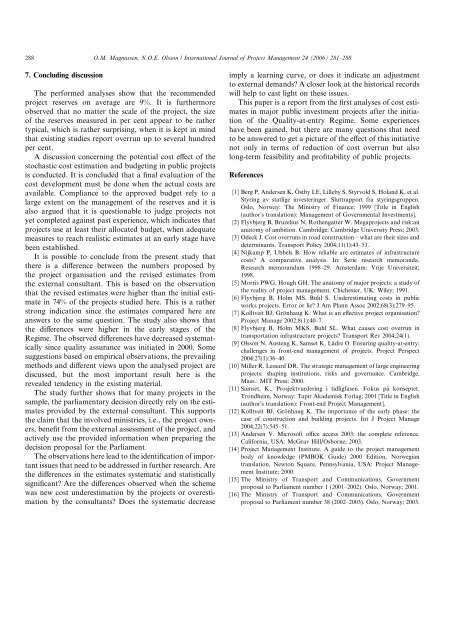Link to thesis - Concept - NTNU
Link to thesis - Concept - NTNU
Link to thesis - Concept - NTNU
Create successful ePaper yourself
Turn your PDF publications into a flip-book with our unique Google optimized e-Paper software.
288 O.M. Magnussen, N.O.E. Olsson / International Journal of Project Management 24 (2006) 281–2887. Concluding discussionThe performed analyses show that the recommendedproject reserves on average are 9%. It is furthermoreobserved that no matter the scale of the project, the sizeof the reserves measured in per cent appear <strong>to</strong> be rathertypical, which is rather surprising, when it is kept in mindthat existing studies report overrun up <strong>to</strong> several hundredper cent.A discussion concerning the potential cost effect of thes<strong>to</strong>chastic cost estimation and budgeting in public projectsis conducted. It is concluded that a final evaluation of thecost development must be done when the actual costs areavailable. Compliance <strong>to</strong> the approved budget rely <strong>to</strong> alarge extent on the management of the reserves and it isalso argued that it is questionable <strong>to</strong> judge projects notyet completed against past experience, which indicates thatprojects use at least their allocated budget, when adequatemeasures <strong>to</strong> reach realistic estimates at an early stage havebeen established.It is possible <strong>to</strong> conclude from the present study thatthere is a difference between the numbers proposed bythe project organisation and the revised estimates fromthe external consultant. This is based on the observationthat the revised estimates were higher than the initial estimatein 74% of the projects studied here. This is a ratherstrong indication since the estimates compared here areanswers <strong>to</strong> the same question. The study also shows thatthe differences were higher in the early stages of theRegime. The observed differences have decreased systematicallysince quality assurance was initiated in 2000. Somesuggestions based on empirical observations, the prevailingmethods and different views upon the analysed project arediscussed, but the most important result here is therevealed tendency in the existing material.The study further shows that for many projects in thesample, the parliamentary decision directly rely on the estimatesprovided by the external consultant. This supportsthe claim that the involved ministries, i.e., the project owners,benefit from the external assessment of the project, andactively use the provided information when preparing thedecision proposal for the Parliament.The observations here lead <strong>to</strong> the identification of importantissues that need <strong>to</strong> be addressed in further research. Arethe differences in the estimates systematic and statisticallysignificant? Are the differences observed when the schemewas new cost underestimation by the projects or overestimationby the consultants? Does the systematic decreaseimply a learning curve, or does it indicate an adjustment<strong>to</strong> external demands? A closer look at the his<strong>to</strong>rical recordswill help <strong>to</strong> cast light on these issues.This paper is a report from the first analyses of cost estimatesin major public investment projects after the initiationof the Quality-at-entry Regime. Some experienceshave been gained, but there are many questions that need<strong>to</strong> be answered <strong>to</strong> get a picture of the effect of this initiativenot only in terms of reduction of cost overrun but alsolong-term feasibility and profitability of public projects.References[1] Berg P, Andersen K, Östby LE, Lilleby S, Styrvold S, Holand K, et al.Styring av statlige investeringer. Sluttrapport fra styringsgruppen.Oslo, Norway: The Ministry of Finance; 1999 [Title in English(authorÕs translation): Management of Governmental Investments].[2] Flyvbjerg B, Bruzelius N, Rothengatter W. Megaprojects and risk:anana<strong>to</strong>my of ambition. Cambridge: Cambridge University Press; 2003.[3] Odeck J. Cost overruns in road construction – what are their sizes anddeterminants. Transport Policy 2004;11(1):43–53.[4] Nijkamp P, Ubbels B. How reliable are estimates of infrastructurecosts? A comparative analysis. In: Serie research memoranda.Research memorandum 1998–29. Amsterdam: Vrije Universiteit;1998.[5] Morris PWG, Hough GH. The ana<strong>to</strong>my of major projects: a study ofthe reality of project management. Chichester, UK: Wiley; 1991.[6] Flyvbjerg B, Holm MS, Buhl S. Underestimating costs in publicworks projects. Error or lie? J Am Plann Assoc 2002;68(3):279–95.[7] Kolltveit BJ, Grönhaug K. What is an effective project organisation?Project Manage 2002;8(1):40–7.[8] Flyvbjerg B, Holm MKS, Buhl SL. What causes cost overrun intransportation infrastructure projects? Transport Rev 2004;24(1).[9] Olsson N, Austeng K, Samset K, Lädre O. Ensuring quality-at-entry:challenges in front-end management of projects. Project Perspect2004;27(1):36–40.[10] Miller R, Lessard DR. The strategic management of large engineeringprojects: shaping institutions, risks and governance. Cambridge,Mass.: MIT Press; 2000.[11] Samset, K., Prosjektvurdering i tidligfasen. Fokus på konseptet.Trondheim, Norway: Tapir Akademisk Forlag; 2001 [Title in English(authorÕs translation): Front-end Project Management].[12] Kolltveit BJ, Grönhaug K. The importance of the early phase: thecase of construction and building projects. Int J Project Manage2004;22(7):545–51.[13] Andersen V. Microsoft office access 2003: the complete reference.California, USA: McGrav Hill/Osborne; 2003.[14] Project Management Institute. A guide <strong>to</strong> the project managementbody of knowledge (PMBOK Guide) 2000 Edition, Norwegiantranslation, New<strong>to</strong>n Square, Pennsylvania, USA: Project ManagementInstitute; 2000.[15] The Ministry of Transport and Communications, Governmentproposal <strong>to</strong> Parliament number 1 (2001–2002). Oslo, Norway; 2001.[16] The Ministry of Transport and Communications, Governmentproposal <strong>to</strong> Parliament number 38 (2002–2003). Oslo, Norway; 2003.
















